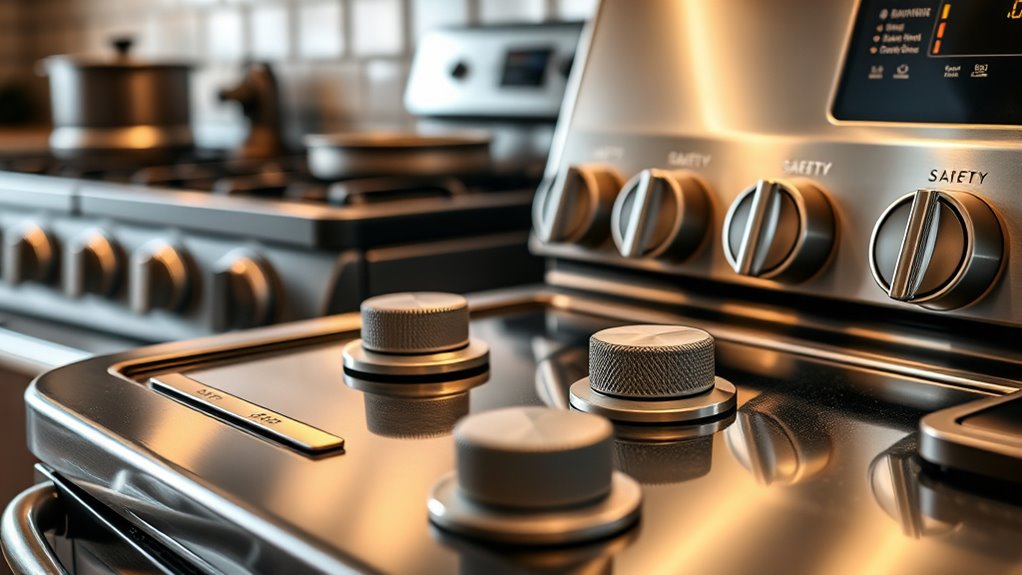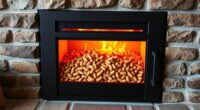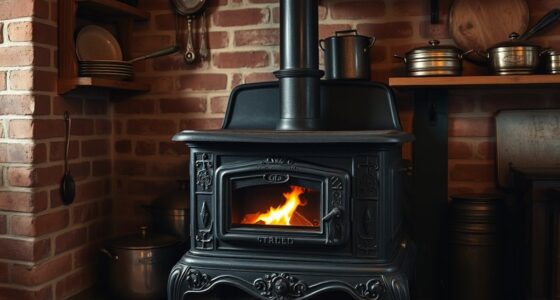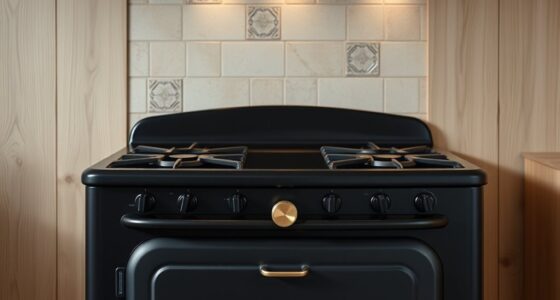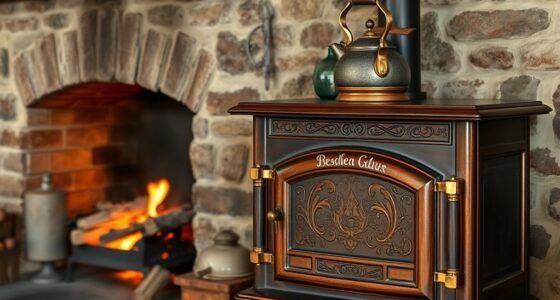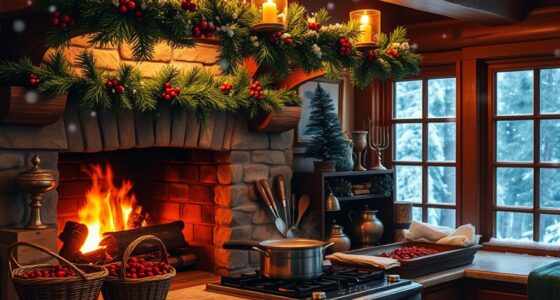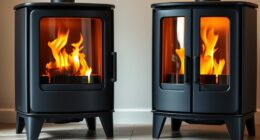The evolution of stove safety standards now emphasizes features like leak detection, child safety locks, and durable, heat-resistant materials, making your kitchen safer. Manufacturers incorporate advanced controls and automatic shut-offs to prevent hazards, while regulations push for smarter, more reliable appliances. Staying updated on these standards helps you choose safer stoves that protect your home from fires, leaks, and burns. If you continue exploring, you’ll discover how these standards keep your kitchen secure and modern.
Key Takeaways
- Safety standards have progressively mandated robust shut-off valves and leak detection systems to prevent gas leaks.
- Child safety features like locks, knob covers, and indicators have become integral to stove designs.
- Materials resistant to high temperatures and corrosion have been adopted for enhanced durability and safety.
- Integration of smart sensors and automatic shut-off functions reflects technological advancements in safety.
- Regulatory updates continuously push manufacturers to meet stricter safety benchmarks, improving overall stove safety.
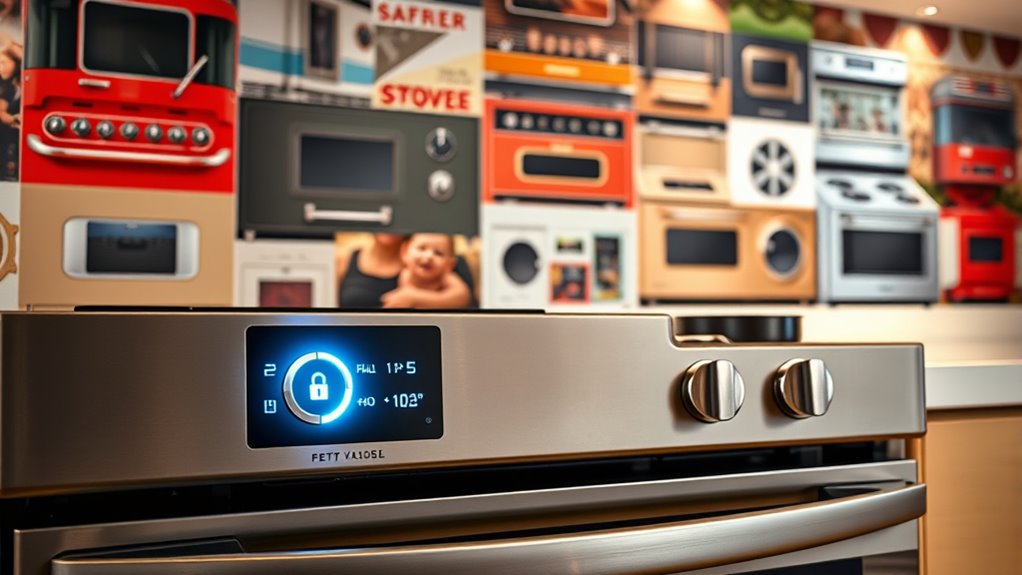
Stove safety standards are essential for protecting yourself and your home from potential hazards. Over the years, these standards have evolved considerably, reflecting advances in technology and a better understanding of common risks like gas leaks and accidents involving children. One of the most critical aspects of modern safety standards is gas leak prevention. Gas leaks can be silent and deadly, so safety measures now emphasize the use of robust shut-off valves, leak detection systems, and materials that reduce the risk of corrosion or damage. These features help you quickly identify and respond to leaks, preventing dangerous buildups of gas that could lead to fires or explosions. Additionally, many new stoves come equipped with automatic shut-off functions that activate if a leak is detected or if the stove is left on for too long, giving you peace of mind and reducing the chance of catastrophic failures.
Child safety features have become a key focus in stove safety standards, recognizing that homes with young children face higher risks of accidents. Manufacturers now incorporate child locks on oven doors and control panels, preventing little hands from turning on burners or opening the oven unintentionally. Knob covers and safety bars are common additions, making it difficult for children to accidentally activate the stove. These measures are designed to keep curious kids safe while allowing adults to operate the appliance normally. Some standards also recommend or require stoves to have clear, easy-to-read indicators that show when burners are hot, which can help prevent accidental burns. The primary goal is to reduce the likelihood of burns, fires, or poisoning from ingesting harmful substances, all while maintaining user convenience.
The evolution of stove safety standards also reflects a shift toward more durable, heat-resistant materials, and smarter, more responsive controls. Continuous improvements in electrical wiring and insulation help prevent electrical fires, while better ventilation systems reduce the buildup of harmful gases and fumes. As safety standards become more rigorous, manufacturers are pushed to innovate and incorporate features that were previously considered optional. This ongoing development means that modern stoves are safer, more reliable, and better equipped to protect you and your loved ones from typical hazards like gas leaks and accidental burns. Staying informed about these standards can help you choose appliances that meet the latest safety benchmarks, ensuring your home remains a safe environment for everyone. Additionally, incorporating smart safety features such as sensors and automatic shut-offs further enhances protection and responsiveness.
Furthermore, ongoing research and regulatory updates continue to shape and improve these safety standards, ensuring they adapt to new technologies and emerging risks. Incorporating advanced materials that are resistant to high temperatures and corrosion also contributes substantially to overall stove safety and longevity. A comprehensive understanding of safety standards allows consumers to make more informed decisions when selecting appliances, ultimately leading to safer homes.
Frequently Asked Questions
How Often Are Stove Safety Standards Reviewed and Updated?
You should know that stove safety standards are typically reviewed and updated every few years, often around 3 to 5 years, to guarantee hazard prevention and incorporate new manufacturing certifications. These updates come from safety agencies and industry groups working to improve safety features. Staying informed about these revisions helps you choose safer stoves and ensure your appliances meet the latest safety requirements, reducing risks in your home.
Are There Different Safety Standards for Residential and Commercial Stoves?
You’re asking if safety standards differ for residential and commercial stoves, and the answer is yes. Commercial stoves prioritize appliance durability and energy efficiency, so their safety standards are often more stringent to withstand heavy use. Residential models focus on user safety and energy savings. It’s a case of apples and oranges, ensuring each type meets specific safety requirements tailored to their environment and usage.
What Are the Penalties for Non-Compliance With Safety Standards?
If you don’t comply with stove safety standards, penalty enforcement can include hefty fines, product recalls, or even legal action. To encourage compliance, authorities offer incentives like certifications or reduced inspection frequency. Staying compliant not only avoids these penalties but also boosts consumer trust and safety. Make sure you follow all regulations carefully, as non-compliance puts your business at risk and compromises user safety.
How Do Safety Standards Vary Internationally?
You’ll find that safety standards vary internationally due to regional differences and specific regulations. Countries like the US, EU, and Japan have distinct international regulations that set different requirements for stove safety. These differences influence manufacturing, testing, and certification processes. To guarantee compliance, you need to understand the regional standards applicable to your market, as they reflect local safety priorities, technological capabilities, and legal frameworks.
What Role Do Consumer Complaints Play in Safety Standard Revisions?
Did you know that over 60% of safety standard updates are driven by consumer complaints? Your feedback plays a vital role in shaping safety standards. When you report issues through official reporting mechanisms, manufacturers and regulators identify hazards faster. This direct input helps improve stove safety, ensuring problems are addressed promptly. So, by sharing your experiences, you actively contribute to safer appliances for everyone.
Conclusion
As you can see, stove safety standards have evolved more rapidly than a rocket soaring to the stars. By staying informed and following these standards, you safeguard your home and loved ones from potential disasters. Remember, overlooking safety is like leaving a fire unattended in a fireworks factory — it’s just not worth the risk. Embrace these updates, and guarantee your cooking space remains a safe haven where nothing can go wrong!

